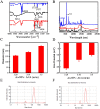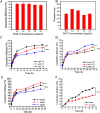K. ZHENG ET AL.Gold-nanoparticle-based multistage drug delivery system for antitumor therapy
- PMID: 36226475
- PMCID: PMC9578448
- DOI: 10.1080/10717544.2022.2128469
K. ZHENG ET AL.Gold-nanoparticle-based multistage drug delivery system for antitumor therapy
Abstract
Nanoparticles can promote the accumulation of drugs in tumors. However, they find limited clinical applications because they cannot easily penetrate the stroma of cancer tissues, and it is difficult to control drug release. We developed a multiresponse multistage drug-delivery nanogel with improved tumor permeability and responsiveness to the tumor microenvironment for the controlled delivery of anticancer agents. For this purpose, ∼100 nm multistage drug delivery nanogels with pH, redox, near-infrared stimulation, and enzyme responsiveness were grown in situ using 20 nm gold nanoparticles (AuNPs) via an emulsion-aiding crosslinking technique with cysteine crosslinker. An alginate cysteine AuNP (ACA) nanocarrier can efficiently load the cationic drug doxorubicin (DOX) to produce a multistage drug delivery nanocarrier (DOX@ACA). DOX@ACA can maintain the slow release of DOX and reduce its toxicity. In cancer tissues, the high pH and reductase microenvironment combined with the in vitro delivery of alginate and near-infrared light drove drug release. The developed nanoparticles effectively inhibited cancer cells, and in vivo evaluations showed that they effectively enhanced antitumor activity while having negligible in vivo toxicity to major organs.
Keywords: Alginate; antitumor therapy; gold nanoparticle; multistage drug delivery; nanogel; pH/redox/enzyme responsiveness.
Conflict of interest statement
No potential conflict of interest was reported by the authors.
Figures







Similar articles
-
Gold Nanoparticle-Incorporated Chitosan Nanogels as a Theranostic Nanoplatform for CT Imaging and Tumour Chemotherapy.Int J Nanomedicine. 2022 Oct 12;17:4757-4772. doi: 10.2147/IJN.S375999. eCollection 2022. Int J Nanomedicine. 2022. PMID: 36238536 Free PMC article.
-
Doxorubicin-Loaded Carbon Dots Lipid-Coated Calcium Phosphate Nanoparticles for Visual Targeted Delivery and Therapy of Tumor.Int J Nanomedicine. 2020 Jan 21;15:433-444. doi: 10.2147/IJN.S229154. eCollection 2020. Int J Nanomedicine. 2020. PMID: 32021189 Free PMC article.
-
Matrix Metalloproteinase-sensitive Multistage Nanogels Promote Drug Transport in 3D Tumor Model.Theranostics. 2020 Jan 1;10(1):91-108. doi: 10.7150/thno.34851. eCollection 2020. Theranostics. 2020. PMID: 31903108 Free PMC article.
-
pH-Sensitive nanogels for drug delivery in cancer therapy.Biomater Sci. 2021 Feb 9;9(3):574-589. doi: 10.1039/d0bm01729a. Biomater Sci. 2021. PMID: 33306076 Review.
-
Stimuli-Responsive Gold Nanoparticles for Cancer Diagnosis and Therapy.J Funct Biomater. 2016 Jul 21;7(3):19. doi: 10.3390/jfb7020019. J Funct Biomater. 2016. PMID: 27455336 Free PMC article. Review.
Cited by
-
Scope of Onsite, Portable Prevention Diagnostic Strategies for Alternaria Infections in Medicinal Plants.Biosensors (Basel). 2023 Jul 1;13(7):701. doi: 10.3390/bios13070701. Biosensors (Basel). 2023. PMID: 37504100 Free PMC article. Review.
-
UV-Accelerated Synthesis of Gold Nanoparticle-Pluronic Nanocomposites for X-ray Computed Tomography Contrast Enhancement.Polymers (Basel). 2023 May 1;15(9):2163. doi: 10.3390/polym15092163. Polymers (Basel). 2023. PMID: 37177309 Free PMC article.
-
A Review on the Recent Advancements of Polymer-Modified Mesoporous Silica Nanoparticles for Drug Delivery Under Stimuli-Trigger.Polymers (Basel). 2025 Jun 13;17(12):1640. doi: 10.3390/polym17121640. Polymers (Basel). 2025. PMID: 40574168 Free PMC article. Review.
-
Natural compounds-based nanomedicines for cancer treatment: Future directions and challenges.Drug Deliv Transl Res. 2024 Oct;14(10):2845-2916. doi: 10.1007/s13346-024-01649-z. Epub 2024 Jul 13. Drug Deliv Transl Res. 2024. PMID: 39003425 Free PMC article. Review.
-
Surface Modification of Mesoporous Silica Nanoparticles for Application in Targeted Delivery Systems of Antitumour Drugs.Polymers (Basel). 2024 Apr 16;16(8):1105. doi: 10.3390/polym16081105. Polymers (Basel). 2024. PMID: 38675024 Free PMC article. Review.
References
-
- Bauleth-Ramos T, Shih T-Y, Shahbazi M-A, et al. (2019). Acetalated dextran nanoparticles loaded into an injectable alginate cryogel for combined chemotherapy and cancer vaccination. Adv Funct Mater 29:1903686.
-
- Boedtkjer E, Pedersen SF. (2020). The acidic tumor microenvironment as a driver of cancer. Annu Rev Physiol 82:103–26. - PubMed
-
- Chen T, Gu T, Cheng L, et al. (2020). Porous Pt nanoparticles loaded with doxorubicin to enable synergistic chemo-/electrodynamic therapy. Biomaterials 255:120202. - PubMed
MeSH terms
Substances
LinkOut - more resources
Full Text Sources
